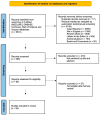Fournier's Gangrene Surgical Reconstruction: A Systematic Review
- PMID: 39064124
- PMCID: PMC11278345
- DOI: 10.3390/jcm13144085
Fournier's Gangrene Surgical Reconstruction: A Systematic Review
Abstract
Fournier's gangrene (FG) is a rare form of necrotizing fasciitis of the perineal, genital, or perianal region. It is characterized by an aggressive course and high mortality rate, over 20%. FG demands immediate treatment including resuscitation maneuvers, intravenous antibiotic therapy and early surgical debridement. Background/Objectives: The gold-standard treatment for FG is surgical reconstruction. However, up to date, no precise guidelines exist. Thus, we decided to systematically review the literature, focusing on FG contemporary approaches to reconstructive surgery, aiming to analyze the various reconstructive strategies and their specific indications. Methods: A systematic review was carried out according to the PRISMA statement by searching various databases from April 2014 to April 2024, using the terms ''Fournier Gangrene OR Fournier Gangrene Reconstruction OR Fournier Gangrene Treatment OR Fournier Gangrene Plastic Surgery OR Necrotizing Fasciitis OR Necrotizing Fasciitis AND Reconstruction". The eligibility criteria included original studies aimed at discussing FG reconstruction with at least three clinical cases. Results: The final synthesis included 38 articles, and 576 reconstructions were described. Of these, 77.6% were minimally invasive strategies (direct closure, secondary healing, grafts, and local random flaps), while more invasive reconstructions (loco-regional flaps based on known vascular anatomy) were adopted in 22.4%. No free flaps were reported. Conclusions: FG requires immediate medical interventions including broad-spectrum antibiotic therapy, surgical debridement, adjuvant therapies, and reconstructive surgeries. Taking into account the anatomical characteristics of the inguinal-crural region, skin grafts and local random flaps could offer versatile and effective reconstructions for most FG cases, while the more invasive strategies should be reserved for very few cases. Future research is warranted to define an FG dedicated reconstruction protocol.
Keywords: Fournier gangrene; Fournier gangrene plastic surgery; Fournier gangrene reconstruction; Fournier gangrene treatment; necrotizing fasciitis; necrotizing fasciitis and reconstruction.
Conflict of interest statement
The authors declare no conflicts of interest.
Figures



References
-
- Rodriguez Alonso A., Perez Garcia M.D., Nunez Lopez A., Ojea Calvo A., Alonso Rodrigo A., Rodriguez Iglesias B., Barros Rodriguez J.M., Benavente Delgado J., Nogueira March J.L. Fournier’s gangrene: Anatomo-clinical features in adults and children. Therapy update. Actas Urol. Esp. 2000;24:294–306. doi: 10.1016/s0210-4806(00)72452-1. - DOI - PubMed
Publication types
LinkOut - more resources
Full Text Sources
Miscellaneous

